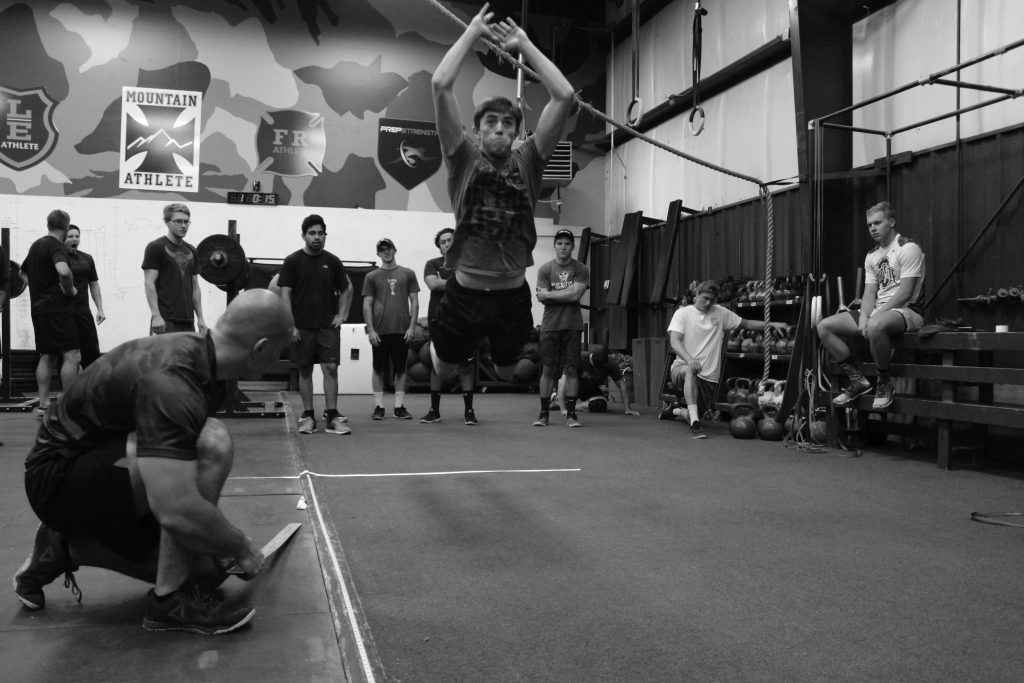
By Charlie Bausman
At the facility in Jackson, our tactical lab rats are stepping away from the daily operator sessions to conduct a 3-week “Geek Cycle” and conduct four concurrent “mini studies” outlined below.
We will be testing different programming methods to see which best improve the following:
- Push ups
- Power Development
- Weighted Pull Ups
- Lower Body Strength
These subjects are studied and analyzed ad nauseum, so why conduct our own research?
We’ve found that the academic research in exercise science or sport physiology is often constrained by strict protocols, uses athletes from a specific sport which has nothing to do with the tactical and mountain arena, and all too often proves to be inconclusive or so complicated it’s useless for actual training.
By studying these topics with the tactical and mountain athlete in mind in a shorter time frame, we can utilize our findings in a “Mission Direct” manner – instantaneously improving performance by putting actionable solutions directly into the hands of those at the tip of the spear.
Mini Study #1: Push Up Improvement – Density vs. Volume
We’ve previously found solid results utilizing an assessment based percentage progression for bodyweight exercises commonly tested in the tactical community. The density format takes eight minutes to complete, and gradually increases the volume scaled to the capabilities of the athlete.
Another common method of push up improvement is with a high volume approach. Basically, doing a lot of push ups several times a week with a traditional rest period between rounds for near total recovery.
With this test, we will see how our approach stacks up to a volume progression.
The Assessment: 2 Minutes Max Push Ups
The athletes partner will place a closed fist (knuckles up) on the ground. The athlete will conduct as many push ups as possible in 2 minutes. The chest must touch the partners fist, and must come to a full extension of the elbows and shoulders. The athlete may rest in the top position, but may not come to their knees or bring their hands off the ground.
Group 1 Progression – Density
In our PFT training plans, we focus on an assessment based percentage progression in a density format. This means the athlete will find their max reps push ups, and then complete a prescribed percentage of the athletes max every 75 seconds, for six rounds. The faster they finish, the more rest they get.
This method allows for an athlete-specific scaling based on the max rep effort. The weekly progression increases volume by 5% weekly, and trains the body to adapt to shortened rest periods.

We are testing our method against a heavier volume method with a traditional set/rep scheme. The volume will also be determined by the athletes max, but will be doubled in comparison to the MTI push-up progression.
Athletes in Group 2 will conduct 9 rounds of push ups at a prescribed percentage of their max rep assessment. They are assigned a standardized rest period (90 seconds) between each round. By increasing the rest period, we can increase the total volume of push ups a athlete will conduct in a training session. The percentages used in this progression are approximately twice the volume of those in Group 1.
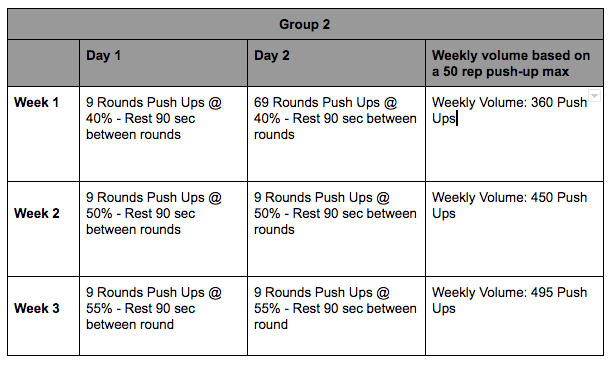
Reassessment
At the end of the 3-week cycle, athletes from Group 1 and Group 2 will re-assess the 2 Minute max push up test, and compare the results to the initial assessment.
Mini Study #2: Power Development – Low Body Strength at Heavy Loads (Hinge Lift) vs. Power at Light Loads (Barbell Squat Jump)
Power is defined as the product of force and velocity. The relationship between force and velocity is inverse – the higher the force (heavier weight), the lower the velocity (decreased speed). On the other side of the spectrum, the lower the force (light weight), the higher the velocity (increased speed).
Is one side of the spectrum more efficient in developing power than the other? Intuitively, a light weight, ballistic lift would lead to greater gains in power for a bodyweight movement such as the Broad Jump. How would it compare to a traditional strength exercise which trains hip extension and posterior strength at high loads and low volume?
In layman’s terms, will making a athlete stronger simply make them more powerful? For experienced athletes like our lab rats, should already strong athletes focus primarily on power exercises? Should weak athletes focus primarily on strength before moving to power movements?
The Assessment: Standing Broad Jump
Each athlete will begin with their feet behind the designated starting line in a standing position. From this static position, the athlete will jump as far forward as possible and “stick” the landing. The feet may not move forward after the jump. The distance is measured from starting line to the back of the athlete’s heels, or whichever foot is farthest back. Each athlete is given three attempts, and the best score is recorded. The athlete may swing the arms and move the hips rearward at the beginning of the jump, but the feet may not move until the jump is initiated.
Group 1 – Low Body Strength at Heavy Loads (Hinge Lift)
Following the Standing Broad Jump assessment, the athletes in Group 1 will conduct a 1-Rep Max (1RM) test for the Hinge Lift. These athletes will use our RAT 6 progression, a 8 Round, 3 Rep scheme at the prescribed loads. The percentage based progression begins at 80%, and ends at 90% of the athlete’s 1RM through the cycle.

Group 2 – Power at Light Load (Barbell Squat Jump)
The Barbell Squat Jump begins with the barbell positioned behind the neck and along the shoulders, similar to a traditional Back Squat. Each athlete will have 75# load. The athlete will jump as high as possible for each rep. The depth of the squat before the jump does not matter – whatever works for maximum power/speed production in the jump. The athlete will land athletically and begin the next rep from the standing position.
Using a density format, each athlete will conduct the assigned number of barbell squat jumps every 60 seconds, for five rounds. The repetition volume will increase, but the load will remain at 75# for the duration of the cycle.
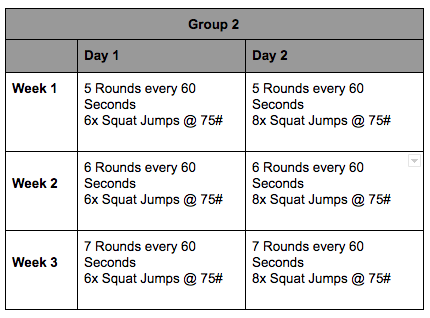
Reassessment
At the end of the 3-week cycle, athletes from Group 1 and Group 2 will re-assess the Standing Broad Jump and compare the results to the initial assessment.
Mini Study #3: Weighted Pull Up Improvement – Weighted Density Progression at 25# vs. Weighted Eccentric Progression @ 50#
MTI has conducted multiple studies on different methods developing Pull Ups, including one major study in conjunction with Dr. Eric Martin of California State University of Monterery Bay. This study was based on improving unloaded Pull Ups and found that different training methods (traditional pull ups, eccentric pull ups, and weighted pull ups) generally led to the same results.
We want to re-examine this study, but with a focus on improving weighted pull ups. For Tactical and Mountain Athlete’s, upper body pulling strength is rarely, if ever, conducted just at bodyweight. What is the best way to improve this fitness demand? We’ll compare weighted pull ups in a density format to heavy loaded eccentric pull ups.
The Assessment: Max Rep Pull Ups at 25#
Wearing a 25# weight vest, the athlete will begin from a dead hang from the pull up bar with a pronated grip (palms facing away). The athlete must raise the body so that the chin raises above the bar, and lower to a full extension of the arms. Any repetition which does not meet the movement standard does not count. The athlete will conduct as many reps as possible without dropping from the bar. The athlete may rest in the hanging position, but the feet can not be supported in any way. No time limit.
Group 1 – Weighted Density Progression at 25#
The athletes in Group 1 will follow the same density progression employed for push ups. The athlete will complete the prescribed percentage of the max rep pull ups at 25# every 75 seconds, for six rounds. The progression will begin at 30%, and end at 40% through the three week cycle. The assessment movement standards apply to all rounds and reps used during this progression.

Group 2 – Weighted Eccentric Progression @ 50#
The athletes in this group will use a pack with 50# for all rounds and reps of the progression. For each repetition, the athlete will jump so that their chin comes over the pull up bar. He will lower himself in a slow, controlled manner for five seconds until coming to the hanging position. The athlete will repeat this eccentric pull up for the prescribed number of repetitions. All athletes must use a pronated grip (palms out) for the exercise.
The prescribed number of repetitions will be a percentage of the weighted pull up assessment number. The progression will begin at 30%, and end at 40% for six rounds. Following each round, the athlete will rest for 90 seconds.
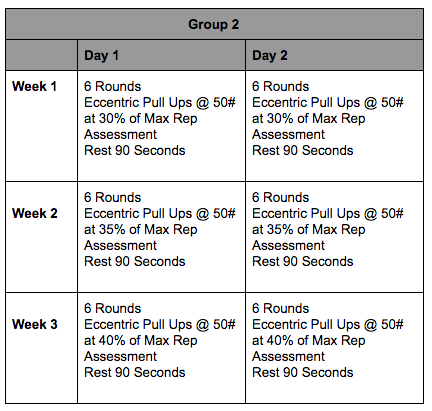
Reassessment
At the end of the 3-week cycle, athletes from Group 1 and Group 2 will re-assess their max weighted pull ups @ 25# and compare the results to the initial assessment.
Mini Study #4: Lower Body Strength – Heavy Front Squat vs. Leg Blasters
The popular belief is that the only way to get stronger with lower body barbell exercises, is by doing lower body barbell exercises at heavy loads. This is not in question – a progression based strength system will get athletes stronger.
However, how would bodyweight exercises with a high low-body demand such as the infamous Leg Blaster compare in increasing a barbell lift? We will compare the two and see if bodyweight movements have a positive effect on lower body maximal strength.
The Assessment: 1RM Front Squat
Each athlete will find their 1RM Front Squat. In the front rack position, the athlete must squat at or below parallel and bring the weight to a full standing position. Any repetition which does not meet the movement standard will not count.
Group 1 – Heavy Front Squat
Group 1 will conduct the Front Squat with our Rat 6 progression. Each training session is 8 Rounds, 3 Rep at the prescribed loads. The percentage based progression begins at 80%, and ends at 90% of the athlete’s 1RM through the cycle. The movement standards are the same as the assessment.
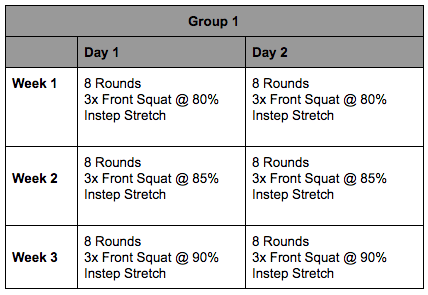
Group 2 – Leg Blasters
The second group will utilize a Leg Blaster progression to develop lower body strength. The athletes will begin with a combination of Mini Leg Blasters and full Leg Blasters.
1x Mini Leg Blaster:
10x air squats +
10x in-place lunges (5x each leg) +
10x jumping lunges (5x each leg) +
5x Squat Jumps
Performed as quickly as possible one exercise immediately after the other.
1x Leg Blaster:
20x air squats +
20x in-place lunges (10x each leg) +
20x jumping lunges (10x each leg) +
10x squat jumps
Performed as quickly as possible one exercise immediately after the other.
Between each Mini Leg Blaster the athlete will rest 60 seconds, and 90 seconds after each full Leg Blaster. The progression will begin with 10x Mini Leg Blasters, and end with 5x Leg Blasters.
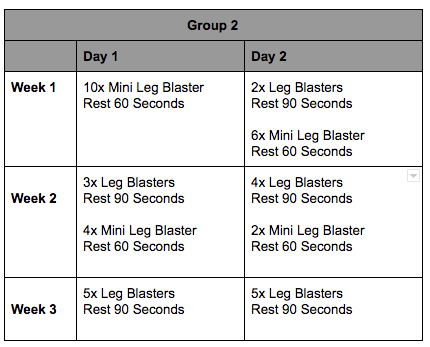
Reassessment
At the end of the 3-week cycle, athletes from Group 1 and Group 2 will re-assess their 1RM Front Squat and compare the results to the initial assessment.
Summary and Thoughts Going Forward
We’ve found that 3-week cycle is enough time to effectively conduct a mini study. Many may argue that a longer cycle is needed due to early adaptation to the exercises being conducted and tested. Our lab rats all have multiple years of training under their belt. We feel this will allow us to shorten the cycle as the early adaptation will not be as prominent as compared to a untrained athlete.
The power development testing is the most intricate, and we’re discussing other methods which may allow for a more easily progressed method in developing power. For example, a loaded box jump at 25# with fewer repetitions per round (compared to the squat jump) would allow us to incrementally increase the height of the box. This system may also be more efficient in scaling the exercise to the individual’s capabilities in terms of power output. We’re not sure.
Another problem we may face is the viability of conducting multiple concurrent tests. Will the front squat group have an advantage in developing extra strength for power development? Will the heavier volume of push ups give an advantage for the weighted pull up test? Again – not sure.
If interested, the full 3-week cycle for Group 1 and Group 2 is outlined below. Complete the cycle and let us know how your assessment and reassessments compared. We’re looking forward to seeing the results and continuing to refine our own methods in developing the most efficient training for tactical and mountain athletes.
Questions/Feedback?
Email coach@mtntactical.com
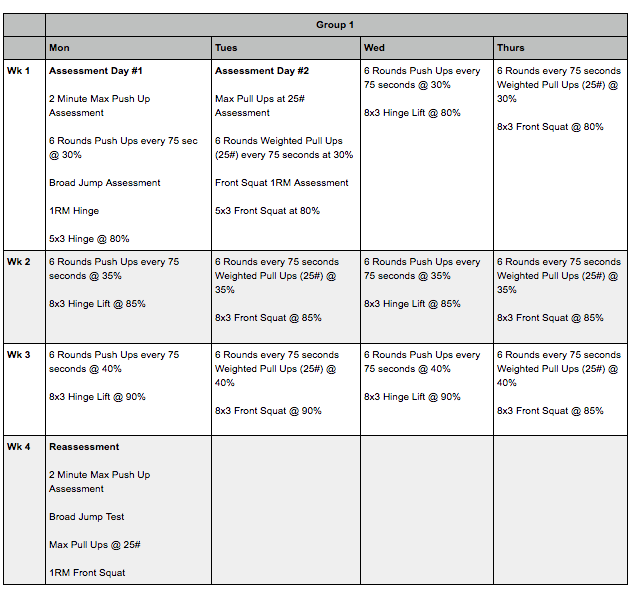

STAY UPDATED
Sign-up for our BETA newsletter. Training tips, research updates, videos and articles - and we’ll never sell your info.
